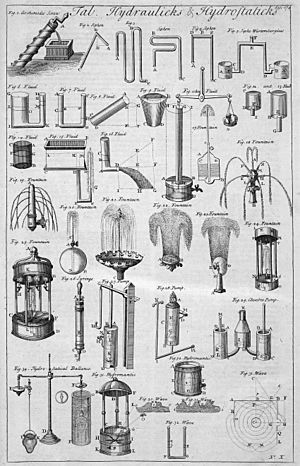Fluid statics facts for kids

Fluid statics (also called hydrostatics) is the study of fluids when they are not moving. Think of fluids as liquids like water or gases like air. This part of fluid mechanics helps us understand how fluids stay still and balanced. It's all about the conditions where fluids are at rest in a stable way.
When a fluid pushes against the sides of something, like water in a swimming pool pushing on the walls, that push is called hydrostatic pressure. The idea of using fluids to do work, like in car brakes or heavy machinery, is known as hydraulics. If fluids are moving, that's a different area called fluid dynamics.
Contents
What is Fluid Statics?
Fluid statics is a branch of science that focuses on fluids that are completely still. It explores how these fluids behave and what forces act on them when they are not flowing. This field is very important for understanding things like how boats float or how dams hold back water.
Fluids at Rest
When we talk about fluids at rest, we mean they are in a state of hydrostatic equilibrium. This is a fancy way of saying all the forces acting on the fluid are balanced, so it doesn't move. Imagine a glass of water sitting on a table. The water isn't flowing or sloshing around; it's at rest. Fluid statics helps us understand why it stays that way and what pressure it creates.
Understanding Hydrostatic Pressure
Hydrostatic pressure is the pressure that a fluid exerts because of its weight. The deeper you go into a fluid, the more pressure there is. This is why your ears might pop when you dive deep into a swimming pool or the ocean. The water above you is pushing down, creating pressure. This pressure acts in all directions at any given depth.
How Pressure Works in Fluids
Imagine a tall column of water. The water at the bottom has the weight of all the water above it pressing down. This creates more pressure at the bottom than at the top. This principle is used in many real-world applications, from water towers that provide pressure to homes to the design of submarines.
Fluid Statics vs. Fluid Dynamics
It's easy to confuse fluid statics with other parts of fluid mechanics.
- Fluid statics is about fluids that are not moving.
- Fluid dynamics is about fluids that are moving. This includes things like how water flows in a river or how air moves around an airplane.
- Hydraulics is a practical application where we use fluids, usually liquids, to create force or movement. Think of the hydraulic lifts that raise cars in a garage.
Real-World Uses of Fluid Statics
The principles of fluid statics are used in many everyday things and advanced technologies.
- Boats and Ships: Understanding how objects float (buoyancy) is a key part of fluid statics. Ships float because the upward push from the water (buoyant force) is equal to the ship's weight.
- Dams: Engineers use fluid statics to design dams that can safely hold back huge amounts of water, calculating the immense pressure the water exerts.
- Hydraulic Systems: While hydraulics often involves moving fluids, the basic understanding of pressure in a contained fluid comes from fluid statics.
- Weather: The pressure of the air (atmospheric pressure) is a concept from fluid statics. Changes in air pressure can tell us about upcoming weather.
See also

